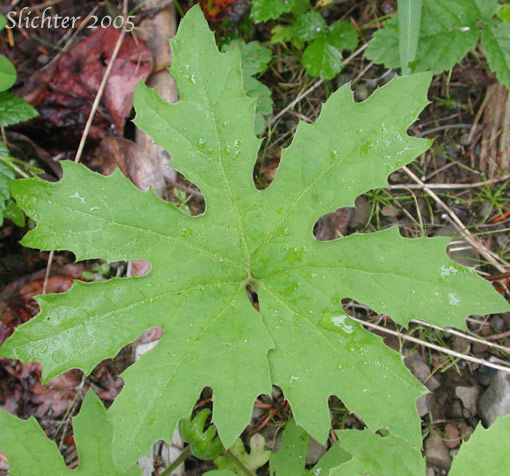 The
photo at right shows the simple but palmately lobed basal leaf of seet coltsfoot.
The
photo at right shows the simple but palmately lobed basal leaf of seet coltsfoot.
Sweet coltsfoot is an interesting perennial wildflower suitable for low, moist places in gardens west of the Cascades. One to several erect stems arise 10-50 cm high from creeping rhizomes. The leaves are basal with long petioles and wide, palmately veined and lobed blades. The lobes are somewhat toothed. The blades may be as wide as 40 cm under favorable conditions. The upper blade surfaces are smooth without hairs or perhaps with some coarse or stiff hairs while the under surfaces of the leaves are loosely white woolly haired below. Any leaves on the stems exist more as parallel veined bracts which are much reduced in size up the stem.
The flower heads are rounded corymbs or racemes of many flower heads at the tips of long, thick stalks. The involucres of individual heads range from 5-9 mm long. The flower heads are white to light purple with the female flowers having short rays.
Sweet coltsfoot has had a number of historical uses. The stems may be boiled or stir-fried. The leaves, although thick and felt-like, may be prepared like cooked spinach for consumption. All parts of the plant above ground have a slightly salty flavor and hence were once used as a salt substitute.
The plant has been used for many years to treat respiratory ailments as an expectorant and cough suppressant. Decoctions of the plants have been used as a treatment on arthritic joints. However, it should be cautioned that coltsfoot contains a good dosage of alkaloids which may prove harmful when consumed in large quantities.
Sweet coltsfoot may be found in moist meadows, seeps, ditches and streambanks. Plants tend to need fairly consistent moisture at their feet. Variety palmatus is generally found at lower elevations than the other varieties where their ranges overlap.
Sweet coltsfoot may be found from northern Canada south to California and east tow Minnesota, Michigan and Massachusetts.